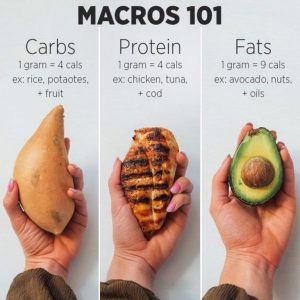Do you know those fitness people who just seem to have it all together? The ones that make staying in shape look as easy as pie? Their secret weapon might just be understanding macronutrients or “macros” for short. It’s like they’ve cracked some secret nutritional code, and in this article, we’re going to cover everything you need to know so you can get the results you want.
What are macros, exactly?
Macros are the powerhouses of our diet, consisting of carbohydrates, proteins, and fats. Imagine your calories as your weekly financial budget, and macros as the vital expenditures, such as rent, utilities, and transportation, in the world of nutrition. Instead of managing your money, you’re effectively managing your intake of these essential nutrients.
Understanding macros and macro calories
But what exactly do these nutrients do, what are macro calories, and why are they crucial additions to your diet?
Protein
Let’s delve into the ever-popular topic of protein. Protein has undeniably captured our attention, bombarding us online, in supermarkets, and gracing the pages of our favourite magazines. Its widespread coverage is well-deserved, thanks to its impressive qualities. As mentioned earlier, protein boasts the highest thermic effect of feeding, meaning it leaves you feeling the most satisfied after consumption. This makes it the dream nutrient for any dieter, as it effectively keeps hunger at bay while aiding in the daily burning of calories. With a caloric value of 4 calories per gram, protein shares the same energy content as carbohydrates. However, rather than being solely used as an energy source, it plays a crucial role in building muscle, facilitating recovery, enhancing skin, hair, and nail health, as well as promoting bone health. Including protein in your diet is absolutely vital for these reasons.
Extensive research has revealed that protein is the most frequently overlooked macronutrient in comparison to carbohydrates and fats. This discrepancy is primarily attributed to factors such as limited availability and cost. However, it has become virtually impossible to Woolies and Coles aisles without encountering an abundance of high-protein snacks vying for your attention.
The question remains: How much protein do you truly require?
Well, like anything, it depends. If you fall into the general population category, where you have a sedentary job and visit the gym 2-3 times a week, aiming for a protein intake of 1.5-2 times your body weight appears to be sufficient. For those who frequent the gym more regularly and consider themselves everyday athletes, it may be advisable to increase protein consumption to 2-2.5 times their body weight. Finally, for advanced athletes, powerlifters, and bodybuilders, the protein intake can go as high as 2.5-3 times their body weight.
Fats
Fats, while being the most calorie-dense macronutrient at 9 calories per gram, do not inherently make you gain weight. In fact, fats are crucial for our overall health, as they contribute to hormonal and cellular functions, and aid in nutrient absorption. Just like the other macronutrients, fats should be included in your diet.
Although fats are typically slower to digest, they provide a greater sense of satiety compared to carbohydrates. This explains the popularity of diets like Atkins in the past, as they helped people stave off hunger while attempting to lose weight. However, we now understand that weight loss primarily relies on maintaining a calorie deficit, and there is no magical formula that reigns superior.
Each macronutrient offers unique advantages, but the key lies in managing overall calorie intake.
Carbohydrates
Carbohydrates, often referred to as the fuel for both your brain and muscles, serve as the primary energy source for your body. As mentioned earlier, they provide 4 calories per gram. Carbohydrates play a vital role in supplying your muscles with glycogen stores, which are crucial for muscular contractions, movement, and generating force in your day-to-day activities.
Thus, avoiding carbohydrates is not recommended for optimal performance, and it is also a misconception that they should be eliminated for effective fat loss. In fact, when aiming to lose weight, maintaining a high level of output and training is key to sustaining energy expenditure.
Additionally, preserving muscle mass is essential during the dieting process, as greater muscle mass leads to a higher basal metabolic rate (BMR). Therefore, it is important to maintain an adequate level of carbohydrates to fuel performance, regardless of the specific goal.
Step-by-Step Guide on How to Count Macros
The concept of ‘counting macros’ has become a popular technique for managing diet, particularly for those looking to lose weight, build muscle, or enhance athletic performance. Understanding how to count macros and realising the importance of protein macros as well as carbohydrates and fats, can help you fine-tune a dietary strategy that best supports your personal goals and lifestyle.
1. Determining Your Total Daily Energy Expenditure (TDEE)
In order to chart a path towards your destination, it is crucial to first understand your current location. Determining your Total Daily Energy Expenditure (TDEE) enables us to estimate the approximate number of calories you burn in a day, taking into account factors such as your Basal Metabolic Rate (BMR), physical activity level, and the thermic effect of food. By calculating your TDEE, we gain valuable insights that lay the foundation for effective nutritional planning and goal setting.
Try using a simple TDEE calculator which can be found online.
Total Daily Energy Expenditure (TDEE) can be broken down into two main components: Resting Energy Expenditure (REE) and Non-Resting Energy Expenditure (NREE).
REE accounts for approximately 70% of your TDEE and represents the calories your body burns at rest.
On the other hand, NREE makes up roughly 30% of your TDEE and encompasses the energy expended through physical activity, as mentioned earlier. This includes Non-Exercise Activity Thermogenesis (NEAT), which essentially refers to the calories burned during daily movements and activities that are not classified as structured exercise.
Examples of NEAT include walking, cleaning the house, mowing the lawn, and any other activities that involve movement but are not considered formal exercise. Understanding the breakdown of TDEE helps us comprehend the various factors contributing to your overall calorie expenditure throughout the day.
EAT, or Exercise Activity Thermogenesis, refers to the calories burned through exercise and accounts for only 5% of your Total Daily Energy Expenditure (TDEE). While exercise is an important component to consider, it’s essential to note that the majority of energy expenditure does not stem from exercise alone. This realization is particularly crucial if your goal is weight loss, as exercise should not be the primary focus.
On the other hand, TEF, or the Thermic Effect of Feeding, constitutes approximately 10% of your TDEE, which is twice the amount of calories burned through exercise. TEF represents the energy expended during the digestion and processing of food. This is where the role of macronutrients becomes significant, as different macronutrients have varying effects on TEF. Notably, protein has the highest thermic effect of feeding among the macronutrients.
Understanding the contribution of EAT, TEF, and the significance of macros provides valuable insight into optimizing your energy expenditure and aligning it with your goals, especially when it comes to weight loss.
2. Assessing Your Current Intake and Macro Split
After obtaining a rough estimate of your daily energy expenditure, the next crucial step is to determine your current intake. Developing awareness is the initial stride towards initiating behavioural changes, and it is considered a best practice employed by top coaches worldwide.
To gain insights into your current dietary habits, begin by meticulously documenting your food consumption for a few weekdays and a day over the weekend, including precise quantities. Utilizing one of the many free apps available, you can then calculate your total calorie intake and macronutrient breakdown. This exercise empowers you with valuable information and sets the foundation for making informed decisions about your nutrition moving forward.
MyfitnessPal is the most popular and user-friendly and can be downloaded from the App Store.
3. Understanding and adjusting the 40-30-30 rule
Now, let’s play with numbers. You may have come across the 40-30-30 macros rule, which can be visualised as a pie chart where 40% of your macros come from carbohydrates, 30% from protein, and 30% from fats. This ratio is commonly associated with the Zone Diet.
However, it’s important to keep in mind that each of us is unique, and our bodies respond differently based on factors such as morphology, behaviours, and lifestyle. Therefore, it’s crucial to recognise that your body may require a different macro split that aligns better with your individual preferences and needs.
You might need to adjust these percentage ratios based on your specific behaviours, lifestyle, and personal preferences to find the optimal macro distribution that allows your body to perform its happy dance.
Finding the Ideal Carb-Protein-Fat Ratio for Weight Management
When it comes to losing fat, here’s a smart tip: focus on protein! It has some fantastic benefits that can help you reach your goals. First, protein has the highest thermic effect of feeding, which means your body burns more calories just by digesting it. Plus, it’s super filling, so you’ll feel satisfied and less likely to snack on unhealthy stuff.
If you want to make your fat loss journey easier, consider increasing your protein intake to about 35-40%. Trust me, it can make a real difference.
Another trick is to cut back on fats, like avocado or salmon, a bit. Remember, fats contain more macro calories per gram compared to other macros. So, by reducing your fat intake, you can lower your overall calorie intake without feeling like you’re eating less. It’s a sneaky but effective way to trim those extra pounds.
Now, you might have heard of the 40/35/25 ratio for protein, carbs, and fats, respectively. Many people find it helpful for managing their weight. But here’s the deal: the “best” approach doesn’t work for everyone. We’re all unique, and what matters most is finding a balance that works for you and your lifestyle. After all, you’re the one who needs to stick to it.
So, don’t be afraid to experiment and find the macronutrient split that suits you best. It’s all about making your weight management journey enjoyable and sustainable in the long run.
How Do Macros Impact Muscle Gain and Optimal Performance?
Carbohydrates are your best friend as they are going to drive glycogen stored in the muscle which will be available and used to exercise and movement, the more glycogen you have at your disposal and the faster it’s replenished the better you’ll be able to recover and perform.
So, opting for 45-50% carbohydrates, while keeping protein about 30% and then fats at 20-25% total calories, is probably going to be the best play for performance.
Claim your 3-day free gym pass to Crunch Fitness.
Meal Planning & Making Your Life Easy
Now that you have set your macro targets and equipped yourself with tracking tools, it’s time to embark on an exciting culinary adventure—meal planning! This process involves a bit of foodie detective work as you explore and discover which foods are rich in each macronutrient, and ultimately craft meals that align with your goals.
To create meals that meet your specific macro targets, it’s essential to identify foods that are high in the desired macronutrients. For example, if you’re aiming for a higher protein intake, you can explore options such as lean meats, poultry, fish, eggs, dairy products, legumes, and plant-based protein sources. Similarly, when seeking carbohydrates, consider whole grains, fruits, vegetables, and starchy foods like potatoes and rice. And let’s not forget about healthy fats, which can be found in sources like nuts, seeds, avocados, olive oil, and fatty fish.
Armed with this knowledge, you can embark on the delightful journey of prepping meals that are not only nutritionally balanced but also cater to your taste buds. Get creative in the kitchen, experiment with different flavours, textures, and cooking techniques to make each meal a gastronomic delight while staying true to your macro targets.
Remember, meal planning is an opportunity to nourish your body, fuel your goals, and indulge in the pleasure of savouring delicious and goal-oriented dishes. Enjoy the process and embrace the versatility of ingredients as you craft meals that bring you one step closer to achieving your health and fitness aspirations.
Optimising Macro Intake: The Art of Progression and Adjustments
As you journey towards your goals, fine-tuning your macro intake becomes crucial. Regular reassessments ensure that you continue to make significant strides. When implementing changes like increasing your intake for muscle gain or decreasing it for weight loss, it’s advisable to maintain consistency for at least two weeks. If, after this period, your weekly average weight shows no significant changes, you can consider adjusting your total calorie intake by 5-10% in either direction, depending on your goals.
However, it’s important to exercise patience during this process. Rapid adjustments can lead to unwanted weight gain or negative effects on mood, increased hunger, and fatigue. Remember, slow and steady adjustments are key to achieving sustainable results.
Key Takeaways
By understanding how to count macros and balance your macronutrient intake, you can take control of your health and fitness journey.
- Counting macros is not just about hitting numbers; it’s about finding what works best for you as an individual.
- Although counting macros may seem challenging initially, with the right tools and knowledge, it becomes a powerful tool for managing your diet.
- Stay flexible and be willing to make adjustments along the way to find a sustainable approach that suits your lifestyle and promotes long-term health.
- Focus on consuming nutrient-dense whole foods to meet your macro goals, as quality still matters for overall health.
- Keep in mind that counting macros should not become a source of stress. If it causes anxiety, take a step back and reconsider your approach, as mental health is equally important on your health and fitness journey.
- Embrace the journey of understanding macros and enjoy the long-term benefits of managing your macro intake.
Welcome to the macro counting club. We’re excited to see the positive impact it will have on your well-being.


Crunch Fitness Virtual Assistant
 I'd like some help reaching my Fitness goals!
I'd like some help reaching my Fitness goals! I'm an existing member and would like some help!
I'm an existing member and would like some help! I have some questions about becoming a Crunch member!
I have some questions about becoming a Crunch member! AU
AU United States
United States Canada
Canada Costa Rica
Costa Rica Spain
Spain Portugal
Portugal NSW Clubs
NSW Clubs VIC Clubs
VIC Clubs